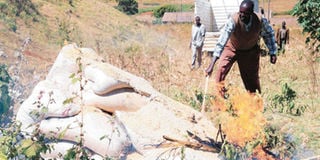Study finds 65 p.c. of flour unfit for eating

A public health official sets alight 71 bags of maize found to be unfit for human consumption on January 30, 2009. Severe aflatoxin poisoning is not new to food-stressed districts in Kenya. Samples taken from 20 of the major maize millers in December from six provinces were found to contain levels of aflatoxins that were unsafe for human consumption. Photo/FILE
Most of the maize flour in the market from some of the major commercial millers is highly contaminated with aflatoxins.
Samples taken from 20 of the major maize millers in December from six provinces were found to contain levels of aflatoxins that were unsafe for human consumption.
The research carried out by the US Centers for Disease Control and Prevention (CDC) and the Ministry of Public Health found that 65 per cent of commercial maizemeal was contaminated with aflatoxins.
Making the presentation yesterday in Nairobi, a researcher with CDC, Dr Margaret McDaniel, said they were now moving on to carry out a national study to establish the extent of the contamination.
University of Nairobi researcher Sheila Okoth explained that although people were not dropping dead from the poison, there was evidence of secondary health problems.
Citing a different study, Dr Okoth said there were worrying rates of aflatoxin-induced kwashiokor in parts of Nandi and increasing cases of cancer in Rift Valley Province.
“While there is too much attention given to aflatoxin in Eastern Province, our studies show the problem is widespread and could be contributory to retardation and poor learning skills in children,” she said.
The study, she also noted, showed high levels of aflatoxin in breast milk, cow’s milk and the traditional alcoholic brew, busaa.
It emerged that much of contaminated maize from last year’s bumper harvest was already in the food chain, with the most spoilt being turned into animal feed.
According to a conference participant, a security firm lost 40 of its 60 dogs to feed suspected to have been contaminated with aflatoxins.
Presenting the latest study results, Dr McDaniel said it was not clear to scientists at what levels the concentration of aflatoxin turned into an acute killer, but the slow accumulation of the poisons in the body leads to complications.
However, a technology that could reduce aflatoxins by up to 80 per cent will be available locally as soon as trials and regulatory issues are sorted out.
According to Dr Peter Cotty of the US Department of Agriculture, more than 3,000 samples of friendly fungus from Eastern Province have been collected for experimentation in collaboration with the Kenya Agricultural Research Institute.




